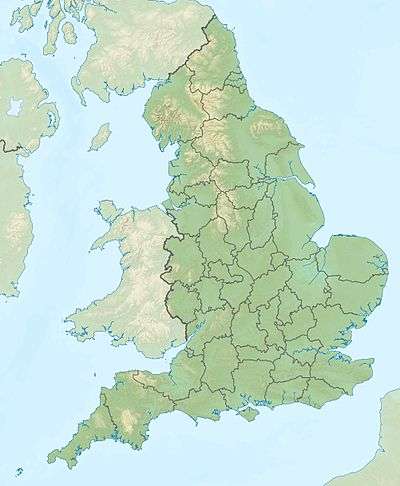Lilstock Formation
The Lilstock Formation is a geologic formation in England. It preserves bivalve, insect and other invertebrate fossils, as well as fossil fish of Agkistracanthus mitgelensis and the basal theropod dinosaur "Zanclodon" cambrensis dating back to the Rhaetian of the Triassic period.[1][2]
| Lilstock Formation Stratigraphic range: Rhaetian ~205–202 Ma | |
|---|---|
| Type | Formation |
| Unit of | Penarth Group |
| Sub-units | Cotham Member, Langport Member |
| Underlies | Blue Lias Formation, Redcar Mudstone Formation |
| Overlies | Westbury Formation |
| Thickness | 1–10 m (3.3–32.8 ft) |
| Lithology | |
| Primary | Shale, siltstone, limestone, mudstone |
| Location | |
| Coordinates | 51.2°N 3.3°W |
| Approximate paleocoordinates | 35.5°N 0.5°E |
| Region | England |
| Country | |
| Type section | |
| Named for | Lilstock |
 Lilstock Formation (the United Kingdom)  Lilstock Formation (England) | |
References
- Lilstock Formation at Fossilworks.org
- Galton PM. Bones of large dinosaurs (Prosauropoda and Stegosauria) from the Rhaetic Bone Bed (Upper Triassic) of Aust Cliff, southwest England. Revue de Paléobiologie, Genève. 2005; 24:51–74.
Further reading
- P. B. Brodie. 1845. A History of the Fossil Insects in the Secondary Rocks of England Accompanied by a Particular Account of the Strata in which they Occur, and of the Circumstances Connected with their Preservation 1-130
- C. J. Duffin. 1994. Myriacanthid holocephalans (Chondrichthyes) from the British Late Triassic. Neues Jahrbuch für Geologie und Paläontologie, Abhandlungen 192(1):1-16
This article is issued from Wikipedia. The text is licensed under Creative Commons - Attribution - Sharealike. Additional terms may apply for the media files.